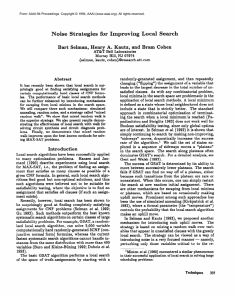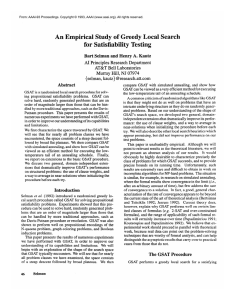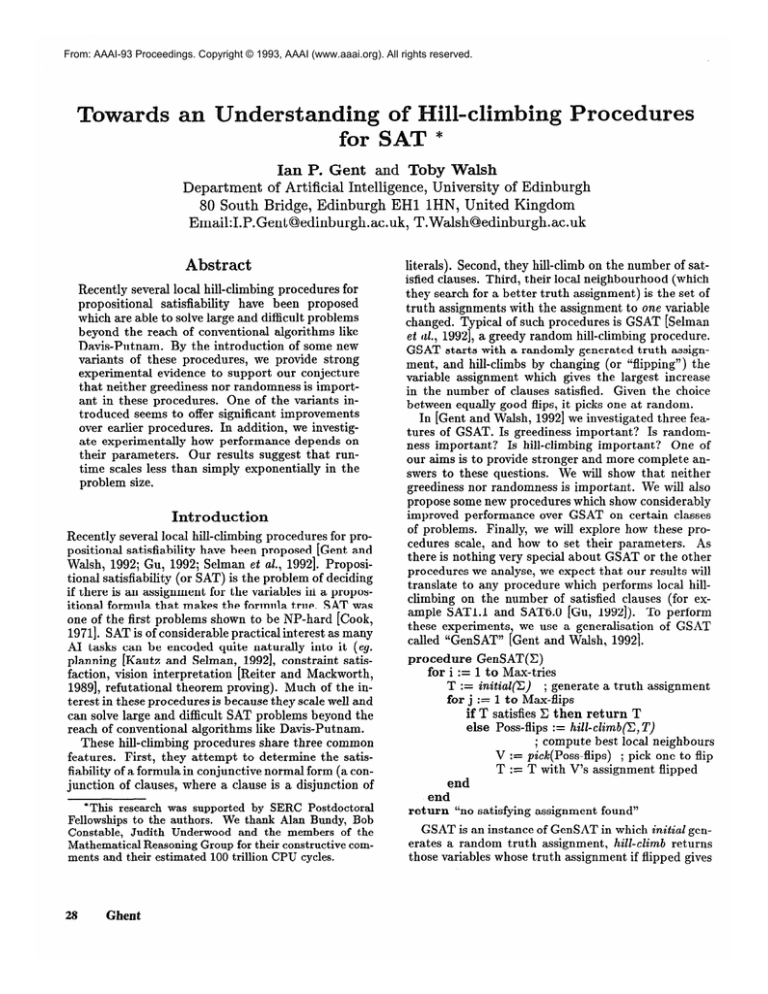
From: AAAI-93 Proceedings. Copyright © 1993, AAAI (www.aaai.org). All rights reserved.
Procedures
Ian P. Gent and Toby Walsh
Department of Artificial Intelligence, University of Edinburgh
80 South Bridge, Edinburgh EHl lHN, United Kingdom
Email:I.P.Gent@edinburgh.ac.uk, T.Walsh@edinburgh.ac.uk
Abstract
Recently several local hill-climbing procedures for
propositional satisfiability have been proposed
which are able to solve large and difficult problems
beyond the reach of conventional algorithms like
Davis-Putnam. By the introduction of some new
variants of these procedures, we provide strong
experimental evidence to support our conjecture
that neither greediness nor randomness is important in these procedures. One of the variants introduced seems to offer significant improvements
over earlier procedures. In addition, we investigate experimentally how performance depends on
their parameters. Our results suggest that runtime scales less than simply exponentially in the
problem size.
Introduction
Recently several local hill-climbing procedures for propositional satisfiability have been proposed [Gent and
Walsh, 1992; Gu, 1992; Selman et al., 19921. Propositional satisfiability (or SAT) is the problem of deciding
if there is an assignment for the variables in a propositional formula that makes the formula true. SAT was
one of the first problems shown to be NP-hard [Cook,
19711. SAT is of considerable practical interest as many
AI tasks can be encoded quite naturally into it (eg.
planning [Kautz and Selman, 19921, constraint satisfaction, vision interpretation [Reiter and Mackworth,
19891, refutational theorem proving). Much of the interest in these procedures is because they scale well and
can solve large and difficult SAT problems beyond the
reach of conventional algorithms like Davis-Putnam.
These hill-climbing procedures share three common
features. First, they attempt to determine the satisfiability of a formula in conjunctive normal form (a conjunction of clauses, where a clause is a disjunction of
*This research was supported by SERC Postdoctoral
Fellowships to the authors. We thank Alan Bundy, Bob
Constable, Judith Underwood and the members of the
Mathematical Reasoning Group for their constructive comments and their estimated 100 trillion CPU cycles.
28
Ghent
literals). Second, they hill-climb on the number of satisfied clauses. Third, their local neighbourhood (which
they search for a better truth assignment) is the set of
truth assignments with the assignment to one variable
changed. Typical of such procedures is GSAT [Selman
et r~k., 19921, a greedy random hill-climbing procedure.
GSAT starts with a randomly generated truth assignment, and hill-climbs by changing (or “flipping”) the
variable assignment which gives the largest increase
in the number of clauses satisfied. Given the choice
between equally good flips, it picks one at random.
In [Gent and Walsh, 19921 we investigated three features of GSAT. Is greediness important? Is randomness important ? Is hill-climbing important? One of
our aims is to provide stronger and more complete answers to these questions. We will show that neither
greediness nor randomness is important. We will also
propose some new procedures which show considerably
improved performance over GSAT on certain classes
of problems. Finally, we will explore how these procedures scale, and how to set their parameters. As
there is nothing very special about GSAT or the other
procedures we analyse, we expect that our results will
translate to any procedure which performs local hillclimbing on the number of satisfied clauses (for example SATI. and SAT&O [Gu, 19921). To perform
these experiments, we use a generalisation of GSAT
called “GenSAT” [Gent and Walsh, 19921.
procedure GenSAT(C)
for i := 1 to Max-tries
T := initial(C)
; generate a truth assignment
for j := 1 to Max-flips
if T satisfies C then return T
ePse Poss-flips := hill-climb@, T)
; compute best local neighbours
V := pick(Poss-flips) ; pick one to flip
T := T with V’s assignment flipped
end
end
ret urn “no satisfying assignment found”
GSAT is an instance of GenSAT in which initial generates a random truth assignment, hill-climb returns
those variables whose truth assignment if flipped gives
the greatest increase in the number of clauses satisfied
(called the “score” from now on) and pick chooses one
of these variables at random. An important feature
of GSAT’s hill-climbing is sideways flips - if there is
no flip which increases the score, a variable is flipped
which does not change the score. GSAT’s performance
degrades greatly without sideways flips.
Greediness and
To study the importance of greediness, we introduced
CSAT [Gent and Walsh, 19921, a cautious variant
of GenSAT. In CSAT, bilk-climb returns all variables
which increase the score when flipped, or if there are
no such variables, all variables which make no change
to the score, or if there are none of these, all variables.
Since we found no problem sets on which CSAT performed significantly worse than GSAT, we conjectured
that greediness is not important [Gent and Walsh,
19921. To test this conjecture, we introduce three new
variants of GenSAT: TSAT, ISAT, and SSAT.
TSAT is timid since hill-climb returns those variables which increase the score the least when flipped,
or if there are no variables which increase the score, all
variables which make no change, or if there are none
of these, all variables. ISAT is indifferent to upwards
and sideways flips since hill-climb returns those variables which do not decrease the score when flipped,
or if there are none of these, all variables. SSAT,
however, is a sideways moving procedure since hillclimb returns those variables which make no change
to the score when flipped, or if there are no such variables, all those variables which increase t’he score, or if
there are none of these, all variables.
We test these procedures on two types of problems:
satisfiability encodings of the n-queens and random kSAT. The n-queens problem is to place n-queens on
an n x n chessboard so that no two queens attack each
other. Its encoding uses n2 variables, each true iff a
particular square is occupied by a queen. Problems in
random k-SAT with N variables and L clauses are generated as follows: a random subset of size k of the N
variables is selected for each clause, and each variable
is made positive or negative with probability i. For
random S-SAT the ratio L/N = 4.3 has been identified as giving problems which are particularly hard for
Davis-Putnam and many other algorithms [Mitchell et
aZ., 1992; Larrabee and Tsuji, 19921. This ratio was
also used in an earlier study of GSAT [Selman et al.,
19921. Since GenSAT variants typically do not determine unsatisfiability, unsatisfiable formulas were filtered
out by the Davis-Putnam procedure.
In every experiment (unless explicitly mentioned
otherwise) Max-flips was set to 5 times the number of
variables and Max-tries to infinity. In Table 1, the figures for “Tries” are the average number of tries taken
until success, while the figures for “Flips” give the average number of flips in successful tries only. The final
two columns record the total number of flips (including
-
ISAT
Random
70 vars
Random
100 vaxs
6 queens
8 queens
16 queens
GSAT
TSAT
ISAT
GSAT
TSAT
ISAT
GSAT
TSAT
ISAT
GSAT
TSAT
ISAT
GSAT
TSAT
ISAT
6.35
10.7
10.2
11.9
25.7
26.1
34.6
2.14
2.26
2.22
1.18
1.20
1.21
1.03
1.04
1.02
Fhps
93.8
96.4
127
158
161
208
261
272
327
65.0
74.1
78.8
84.5
101
112
253
282
339
Total
1310
1180
1460
3550
3390
4030
12600
12800
17100
271
301
298
141
165
178
288
326
365
s.d.
2200
2090
2560
6090
5980
7890
22800
22000
43200
267
296
310
170
171
173
251
295
226
Table 1: Comparison of GSAT, TSAT, and ISAT
unsuccessful tries) and their standard deviations. 1000
experiments were performed in each case, all of which
were successful. To reduce variance, all experiments
used the same randomly generated problems.
The results in table 1 confirm our conjecture that
reediness is not important. Like cautious hill-climbing
lmid hill-climbing gives very
rGent and Walsh, 19921, t’
similar performance to greedy hill-climbing.
The differences between GSAT and TSAT are less than variances we have observed on problem sets of this size.
ISAT does, however, perform significantly worse than
GSAT. ISAT’s performance falls off much more quickly
as the problem size increases. We conjecture that as
the problem size increases, the number of sideways flips
offered increases and these are typically poor moves
compared to upwards flips. Combined with other heur-
istics,
however,
some of these sideways
flips can be
good flips to make, as we show in a later section where
a variant of ISAT gives improved performance over
GSAT. As well as SSAT, we tried a variant of ISAT
which is indifferent to flips which increase the score,
leave it constant or decrease it by 1. Both this variant
and SSAT failed to solve any of 25 random 3-SAT 50
variable problems in 999 tries. We therefore conclude
that you need to perform some sort of hill-climbing.
Greediness has also been used in several local search
procedures for the generation of start positions (eg. in a
constraint satisfaction procedure [Minton et al., 19901,
and in various algorithms for the n-queens problems
[Sosit and Gu, 19911). To investigate whether such
initial greediness would be useful for satisfiability, we
introduce a new variant of GenSAT called OSAT which
is opportunistic in its generation of an initial truth assignment. In OSAT, the score function (number of satisfied clauses) is extended to partial truth assignments
by ignoring unassigned variables. OSAT incrementally
builds an initial truth assignment by considering the
Automated
Reasoning
29
variables in a random order and picking those truth
values which maximize the score; the use of a random
order helps prevent any variable’from dominating. In
addition, if the score is identical for the assignment of a
variable to true and false, a truth assignment is chosen
at random. OSAT is identical to GSAT in all other
respects. A comparison of OSAT and GSAT is given
in table 2. In this and subsequent tables, percentages
give the total flips as a percentage of the comparable
figure for GSAT, and standard deviations are omitted
for reasons of space.
Table 2: Comparison of GSAT and OSAT
OSAT always takes less flips on average than GSAT
on a successful try. OSAT also takes the same or
slightly more tries as GSAT. The total number of flips
performed by OSAT can therefore be slightly less than
GSAT on the same problems. However, if we include
the O(N) computation necessary to perform the greedy
start, OSAT is nearly always slower than GSAT.
To conclude, our results confirm that greediness is
neither important in hill-climbing nor in the generation
of the initial start position. Any form of hill-climbing
which prefers up or sideways moves over downwards
moves (and does not prefer sideways over up moves)
appears to work.
To explore whether the initial truth assignment can
be varied deterministically, and to determine if randomness can be eliminated simultaneously from all
parts of GenSAT, we introduce three new variants:
NSAT, VSAT, VDSAT. NSAT generates initial truth
assignments in “numerical” order. That is, on the nth try, the m-th variable in a truth assignment is set
to true iff the m-th bit of the binary representation of
n is 1. VSAT, by comparison, generates initial truth
assignments to maximize the variability between successive assignments. On the first try, all variables are
set to false. On the second try, all variables are set
to true. On the third try, half the variables are set to
true and half to false, and so on. See [Gent and Walsh,
19931 for details. Since this algorithm cycles through
all possible truth assignments, VSAT is a complete decision procedure for SAT when Max-tries is set to 2jv.
NSAT and VSAT are identical to GSAT in all other respects. VDSAT uses the same start function as VSAT
and is identical to DSAT in all other respects. Unlike
all previous variants, VDSAT is entirely deterministic.
As table 3 demonstrates, NSAT’s performance was
very poor on 50 variable problems. Its performance on
larger problems was even worse. We conjecture that
this poor performance is a consequence of the lack
of variability between successive initial truth assignments. VSAT and VDSAT have initial truth assignments which vary much more than initial truth assignments in NSAT. VSAT’s performance is very close to
GSAT’s. VDSAT performs very similarly to DSAT,
and better than GSAT, on random problems. VDSAT’s performance on the 16 queens problem is poor
because VDSAT is entirely deterministic and the first
try happens to fail.
Randomness
GSAT uses randomness in generating the initial truth
assignment and in picking which variable to flip when
offered more than one. To explore the importance of
such randomness, we introduced in [Gent and Walsh,
19921 three variants of GenSAT: FSAT, DSAT, and
USAT. FSAT uses a fixed initial truth assignment but
is otherwise identical to GSAT. DSAT picks between
equally good variables to flip in a deterministic but fair
way, whilst USAT picks between equally good variables
to flip in a deterministic but unfair wayl. On random k-SAT problems both USAT and FSAT performed
poorly. DSAT, however, performed considerably better than GSAT ( as well as [Gent and Walsh, 19921 see
figures 4 & 5). We therefore concluded that there is
nothing essential about the randomness of picking in
GSAT (although fairness is important) and that the
initial truth assignment must vary from try to try.
‘A procedure is fair if it eventually picks any variable
that is offered continually. USAT picks the least variable in
a fixed ordering. DSAT picks variables in a cyclical order.
30
Ghent
1 VDSAT
2 1 296 1 1576
550% 1
Table 3: Comparison of NSAT, VSAT, and VDSAT
To conclude, randomness is neither important in the
initial start position nor in picking between equally
good variables. However, it is important that successive initial start positions vary on a large number of
variables.
Memory
Information gathered during a run of GenSAT can be
used to guide future search. For example, [Selman and
Kautz, 19931 introduced a variant of GSAT in which
a failed try is used to weight the emphasis given to
clauses by the score function in future tries. They report that this technique enables GSAT to solve problems that it otherwise cannot solve.
In [Gent and Walsh, 19921 we introduced MSAT,
which is like GSAT except that it uses memory to avoid
making the same flip twice in a row except when given
no other choice. MSAT showed improved performance
over GSAT particularly on the n-queens problem, although the improvement declines as problems grow larger. This is, of course, not the only way we can use
memory of the earlier search. In this section we introduce HSAT and IHSAT. These variants of GenSAT
use historical information to choose deterministically
which variable to pick. When offered a choice of variables, HSAT always picks the one that was flipped
longest ago (in the current try): if two variables are
offered which have never been flipped in this try, an arbitrary (but fixed) ordering is used to choose between
them. HSAT is otherwise like GSAT. IHSAT uses the
same pick as HSAT but is indifferent like ISAT. Results
for HSAT and IHSAT are summarised in table 4.
Problem
Random
50 van
Random
Proc
HSAT
IHSAT
HSAT
LSAT
[SAT
:SAT
[SAT
:SAT
[SAT
Tries
Flips
3.82
3.38
4.93
3.84
8.11
58.7
96.0
101
165
184
274
43.3
55.8
44.1
66.2
6.95
1.11
1.08
1.09
:SAT
[SAT
1.08
1.02
:SAT
1.02
156
220
Total
763
690
1480
1160
3740
3250
62.9
70.6
73.9
90.5
183
245
%
58%
53%
42%
33%
30%
26%
23%
26%
52%
64%
64%
85%
Table 4: Comparison of HSAT and IHSAT
Both HSAT and IHSAT perform considerably better
than GSAT. Indeed, both perform better than any previous variant of GenSAT. Many other variants of HSAT
also perform very well (eg. HSAT with cautious hillclimbing, with timid hill-climbing, with VSAT’s start
function). Note also that, unlike MSAT, the improvement in performance does not appear to decline as the
number of variables increases.
To conclude, memory of the current try can significantly improve the performance of many variants. In
particular, picking variables based on the history of the
try rather than randomly is one such improvement.
Running GenSAT
We have studied the behaviour of GenSAT as the functions initial, hill-climb, and pick are varied. However,
we have not discussed the behaviour of GenSAT as we
vary its explicit parameters, Max-tries and Max-flips.
The setting of Max-tries is quite simple - it depends
only on one’s patience. Increasing Max-tries will increase one’s chance of success.
The situation for Max-flips is different to that for
Max-tries. Although increasing Max-flips increases the
probability of success on a given try, it can decrease the
probability of success in a given run time. To understand this fully it is helpful to review some features of
GenSAT’s search identified in [Gent and Walsh, 19921.
GenSAT’s hill-climbing is initially dominated by increasing the number of satisfied clauses. GSAT, for
example, on random S-SAT problems is typically able
to climb for about 0.25N flips, where N is the number
of variables in the problem, increasing the percentage
of satisfied clauses from 87.5% (i of the clauses are initially satisfied by a random assignment) to about 97%.
From now on, there is little climbing; the vast majority
of flips are sideways, neither increasing nor decreasing
the score. Occasionally a flip can increase the score; on
some tries, this happens often enough before Max-flips
is reached that all the clauses are satisfied.
In Figure 1, we have plotted the percentage of problems solved against the total numbers of flips used by
HSAT for 50 variable random problems, with Max-flips
is 150. The dotted lines represent the start of new tries.
During the initial climbing phase almost no problems
are solved: in fact no problems were solved in less that
10 flips on the first try. Note that 10 is 0.2N, approximately the length of the initial climbing phase. This
behaviour is repeated during each try: very few problems are solved during the first 10 flips of a try. After
about 10 flips, there is a dramatic change in the gradient of the graph. There is now a significant chance of
solving a problem with each flip. Again, this behaviour
is repeated on each try. Finally, after about 100 flips of
a given try, the gradient declines noticeably. From now
on, there is a very small chance of solving a problem
during the current try if it has not been solved already.
!
lOO-
50 var / 215 Clause problems
MIdlipS
% *OSolved
604020I
I
0
75
150
I
I
I
I
225
300
I
I
I
>
375
450
Total nips
Figure 1: HSAT, Max-flips = 150
Different values of Max-flips offer a trade-off between
the unproductive initial phase at the start of a try and
Automated
Reasoning
31
the unproductive phase at the end for large Max-flips.
To determine the optimal value, we have plotted in
Figure 2 the average total number of flips used on 50
variable problems against integer values of Max-flips
from 25 to 300 for HSAT, DSAT, and GSAT. For small
values of Max-flips, not enough flips remain after the
hill-climbing phase to give a high chance of success
on each try. Each variant performs much the same.
This is to be expected as each is performing the same
(greedy) hill-climbing. The optimum value for Maxflips is about 60. Since this minimum is not very sharp,
it is not, however, too important to find the exact optimal value. For Max-flips larger than about 100, the
later flips of most tries are unsuccessful and hence lead
to wasted work. As Max-flips increases, the amount of
wasted work increases almost linearly. For everything
but small values of Max-flips, HSAT takes fewer flips
than DSAT, which in turn takes fewer than GSAT. The
type of picking performed thus seems to have a significant effect on the chance of success in a try if more
than a few flips are needed.
Average Total Flips
Ih
2000
50 Var / 215 Clause problems
1600
GSAT
1200
DSAT
800
HSAT
400
s
n
”
1
I
0
I
I
50
150
100
L
I
200
300
250
Max-flips
I
-
Figure 2: Varying Max-flips
Similar results are observed when the problem size is
varied. In Figure 3, we have plotted the average tot’al
number of flips used by HSAT on random problems
against integer values of Max-flips for differing numbers of variables N. The optimal value of Max-flips appears to increase approximately as N2. Even with 100
variable random problems, the optimal value is only
about 2N flips. Figure 3 also supports the claim made
in [Selman et al., 19921 and [Gent and Walsh, 19921
that these hill-climbing procedures appear to scale better than conventional procedures like Davis-Putnam.
To investigate more precisely how various GenSAT
variants scale, Figure 4 gives the average total number of flips used by GSAT, DSAT and HSAT on random problems against the number of variables N at
10 variable intervals. Although the average total flips
increases rapidly with N, the rate of growth seems to
be less than a simple exponential. In addition, the
improvement in performance offered by HSAT over
DSAT, and by DSAT over GSAT increases greatly with
N. One cause of variability in these results is that Maxflips is set to 5N and not its optimal value. In Figure
5 we have therefore plotted the optimal values of the
average total flips against the number of variables at
10 variable intervals using a log scale for clarity. The
performances of GSAT, DSAT and HSAT in Figure 5
are consistent with a small (less than linear) exponential dependence on N. Note that the data does not rule
out a polynomial dependency on N of about order 3.
Further experimentation and a more complete theoretical understanding are needed to choose between these
two interpretations. We can, however, observe (as do
[Selman et al., 1992J) that these hill-climbing procedures have solved some large and difficult random 3SAT problems well beyond the reach of conventional
procedures. At worst, their behaviour appears to be
exponential with a small exponent. Note again that
HSAT offers a real performance advantage over GSAT
and DSAT, not just a constant factor speed-up.
Average Total Flips
2000 f
Average Total Flips
HSAT
I
N=70
1600N=60
32000s
12008UOw
N-50
400-
N=40
16000N=30
L/N=4.3
8000-
O0
N
2N
3N
4N
5N
Max-dips
Figure 3: Varying Max-flips and N
32
Ghent
20
40
60
80
100
Figure 4: Max-flips = 5N
N
120
GSAT
DSAT
HSAT
0
20
80
Figure 5: Max-flips Optimal
elated an
Hill-climbing search has been used in many different
domains, both practical (eg. scheduling) and artificial (eg. 8-puzzle). Only recently, however, has hillclimbing been applied to SAT. Some of the first procedures to hill-climb on the number of satisfied clauses
were proposed in [Gu, 19921. Unfortunately, it is difficult to compare these procedures with GenSAT directly as they use different control structures.
These experiments have been performed with just
two types of SAT problems: random Ic-SAT for k = 3
and L/N = 4.3, and an encoding of the n-queens. Although we expect that similar results would be obtained with other random and structured problem sets,
we intend to confirm this conjecture experimentally. In
particular, we would like to try other-values of k-and
L/N, and other non-random problems (eg. blocks world
planning encoded as SAT [Kautz and Selman, 19921,
boo”lean induction, standard graph colouring problems
encoded as SAT). To test problem sets with large numbers of variables, we intend to implement GenSAT on
a Connection Machine. This will be an interesting exercise as GenSAT appears to be highly parallelizable.
One aspect of GenSAT that we have not probed
in detail is the scoring function. The score function
has always been the number of clauses satisfied. Since
much of the search consists of sideways flips, this is perhaps a little insensitive. We therefore intend to investigate alternative score functions. Finally, we would like
to develop a better theoretical understanding of these
experimental results. Unfortunately, as with simulated
annealing, we fear that such a theoretical analysis may
be rather difficult to construct.
conclusions
Recently, several local hill-climbing procedures for propositional satisfiability have been proposed [Selman et
al., 1992; Gent and Walsh, 19921. In [Gent and Walsh,
19921, we conjectured that neither greediness nor randomness was essential for the effectiveness of the hill-
climbing in these procedures. By the introduction of
some new variants, we have confirmed this conjecture.
Any (random or fair deterministic) hill-climbing procedure which prefers up or sideways moves over downwards moves (and does not prefer sideways over up
moves) appears to work. In addition, we have shown
that randomness is not essential for generating the initial start position, and that greediness here is actually
counter-productive. We have also proposed a new variant, HSAT, which performs much better than previous
procedures on our problem sets. Finally, we have studied in detail how the performance of these procedures
depends on their parameters. At worst, our experimental evidence suggests that they scale with a small
(less than linear) exponential dependence on the problem size. This supports the conjecture made in [Selman
et al., 19921 that such procedures scale well and can
be used to solve large and and difficult SAT problems
beyond the reach of conventional algorithms.
eferences
Cook, S.A. 1971. The complexity of theorem proving
procedures. In Proceedings of the 3rd Annual ACM
Symposium
on the Theory
of Computation.
151-158.
Gent, I. and Walsh, T. 1992. The Enigma of SAT
Hill-climbing Procedures. Research Paper 605, Dept.
of AI, University of Edinburgh.
Gent, I. and Walsh, T. 1993. Towards an Understanding of Hill-climbing Procedures for SAT. Research
Paper, Dept. of AI, University of Edinburgh.
Gu, J. 1992. Efficient local search for very large-scale
satisfiability problems. SIGART Bulletin 3( 1):8-12.
Kautz, H.A. and Selman, B. 1992. Planning as Satisfiability. In Proceedings of the 10th ECAI. 359-363.
Larrabee, T. and Tsuji, Y. 1992. Evidence for a
Satisfiability Threshold for Random 3CNF Formulas.
Technical Report UCSC-CRL-92-42, UC Santa Cruz.
Minton, S.; Johnston, M.; Philips, A.; and Laird, P.
1990. Solving large-scale constraint satisfaction and
scheduling problems using a heuristic repair method.
In Proc. 8th National Conference on AI. 17-24.
Mitchell, D.; Selman, B.; and Levesque, H. 1992.
Hard and easy distributions of SAT problems. In
Proc. 10th National
Conference
on AI. 459-465.
Reiter, R. and Mackworth, A. 1989. A logical framework for depiction and image interpretation. Artificial
Intelligence 41(3):123-155.
Selman, B. and Kautz, H. 1993. Domain-independent
extensions to GSAT. Technical report, AI Principles
Research, AT & T Bell Laboratories, Murray Hill, NJ.
Selman, B.; Levesque, H.; and Mitchell, D. 1992. A
New Method for Solving Hard Satisfiability Problems.
In Proc. 10th National Conference on AI. 440-446.
SosiC, R. and Gu, J. 1991. Fast search algorithms for
the N-queens problem. IEEE Transactions
on Systems, Man, and Cybernetics 21(6):1572-1576.
Automated
Reasoning
33

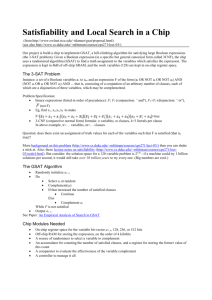
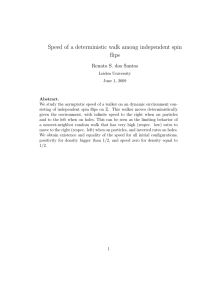


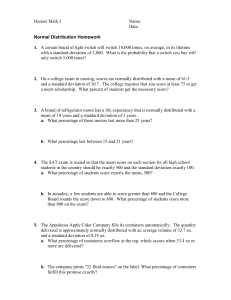
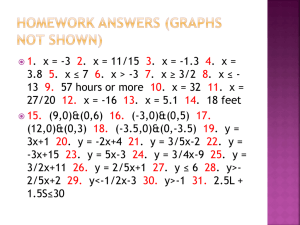
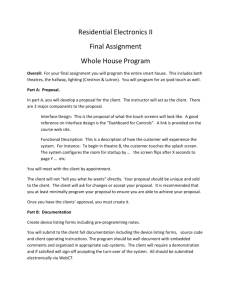
![%Old_\documentstyle[12pt,fullpage,aaai97,psfig]{article](http://s3.studylib.net/store/data/007497215_1-2a14670be8089f5a62979095f69a5ea5-300x300.png)

